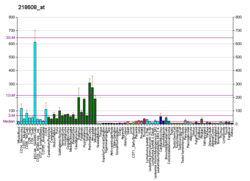Probable cation-transporting ATPase 13A2 is an enzyme that in humans is encoded by the ATP13A2 gene that is involved in the transport of divalent transition metal cations. [5] [6] [7] It appears to protect cells from manganese [8] and zinc toxicity, [9] possibly by causing cellular efflux and/or lysosomal sequestration; and from iron toxicity, possibly by preserving lysosome integrity against iron-induced lipid peroxidation. [10] However, it potentiates the toxic effects of cadmium and nickel on developing neurites, [11] and of the widely used herbicide paraquat [12] possibly by increasing polyamine uptake. [13]
Deficiency is associated with spastic paraplegia and Kufor-Rakeb syndrome, in which there is progressive parkinsonism with dementia. [14]




